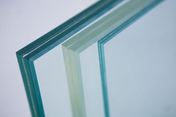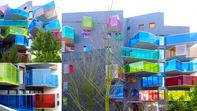Whether we use float glass, half-tempered glass or tempered glass...glass remains breakable and should, other than the esthetic value fulfil its first goal, to secure the balcony. To realize this there is the existence of interlayers. These interlayers are laminated between two or three glass panels (depending on the regulations of your country) in order to hold together glass, when shattered, in order not to hurt underneath walking people.
There are several kinds of interlayers with the most known for glass railings ; the PVB interlayer, the colored Vanceva interlayers, the Saflex DG interlayer and the Sentry interlayer.
Those interlayers can be divided into two categories, the non-structural ( they keep the shattered glass together but do not support the glass) and the structural interlayers which does support the glass when broken or shattered.
There are several kinds of interlayers with the most known for glass railings ; the PVB interlayer, the colored Vanceva interlayers, the Saflex DG interlayer and the Sentry interlayer.
Those interlayers can be divided into two categories, the non-structural ( they keep the shattered glass together but do not support the glass) and the structural interlayers which does support the glass when broken or shattered.
|
Non-structural interlayers
|
Structural interlayer or so called ;
structural glass |
|
PVB
Polyvinylbutyral (PVB) is a polymer ( commonly known as plastic). Typical are the optical transparency, the strength, the flexibility and the excellent adhesive properties with glass materials. |
Vanceva
Vanceva interlayers are coloured PVB's. By mixing basic colors, bleu with green makes yellow, we can obtain an huge range of coulors to play with. |
Saflex DG
Saflex DG is also a PVB but a special one. Other than the normal PVB, the Saflex DG is 100 X stiffer which makes it a structural PVB. This means, when glass breaks and shatters, the glass will still be supported by the Salfex DG interlayer in order to maintain the function of the railing system. |
Sentry
Sentry is not family of the PVB's but is an Ionoplast Like the Saflex DG the Sentry Interlayer is 100 X stiffer than a traditional PVB. The Sentry can also be seen as a structural interlayer. |
Where do the structural interlayers come from ?
The structural interlayers like Saflex DG & Sentry find their origin in glass applications in parts of the world with a lot of earthquake zones and cyclone prone areas. Due to their extreem combination of stiffness, flexibility and adhesive properties they support glass in a much more efficient way in order to sustain large forces and wind pressure than tradiontel PVB's.
This results in the possibility of use of thinner glass and in certain applications float glass instead of tempered glass.
Why should we still use the traditional PVB or Vanceva's ?
The traditional PVB's can still be used for railing systems where the glass is used as fill panel or when a rail top is used on top of the glass.
The Vanceva colored interlayers can perfectly be laminated together with a Saflex DG for instance, in order to combine the colors of the PVB's with the strong characteristics of the Saflex DG interlayer.
The traditional PVB's can still be used for railing systems where the glass is used as fill panel or when a rail top is used on top of the glass.
The Vanceva colored interlayers can perfectly be laminated together with a Saflex DG for instance, in order to combine the colors of the PVB's with the strong characteristics of the Saflex DG interlayer.
What should be used ?
Each application ( private residential use, office use or public spaces, inside or outside balcony with wind load) and each country has its regulations which makes it difficult to publish a straight answer.
For each application we have to look to the circumstances and starting from that we can propose the best solution with one main purpose....the absolute safety I
Each application ( private residential use, office use or public spaces, inside or outside balcony with wind load) and each country has its regulations which makes it difficult to publish a straight answer.
For each application we have to look to the circumstances and starting from that we can propose the best solution with one main purpose....the absolute safety I

